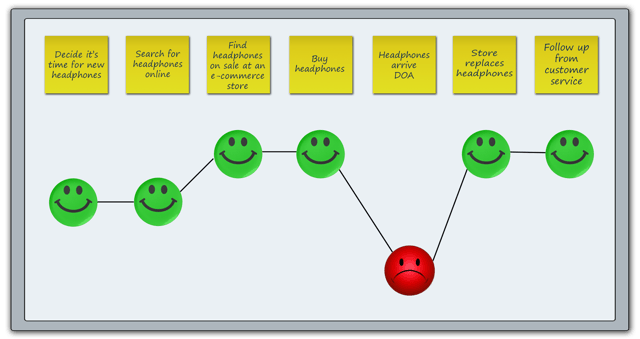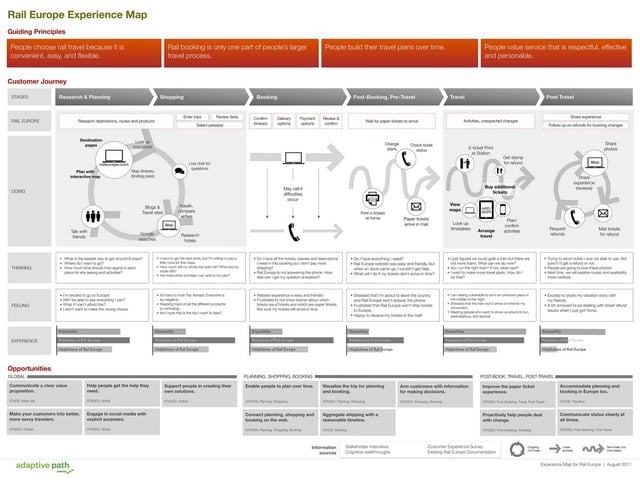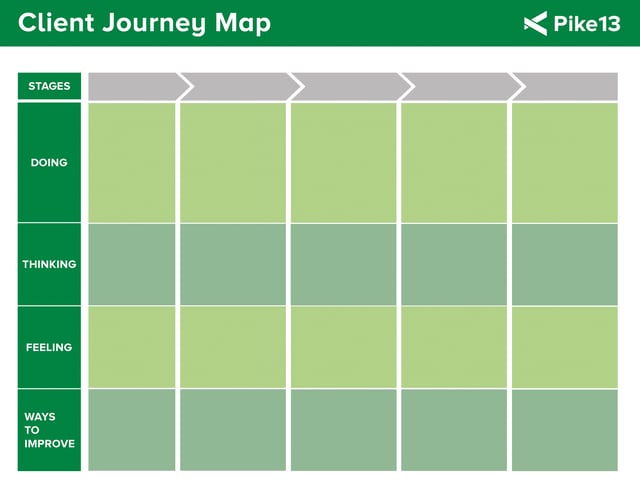As a business owner, you’re already well aware that some business processes are a monumental pain the butt for you. But do you know how your clients feel about them?
A client journey map exposes the parts of your business that clients love, and the parts that cause them frustration. Use the map as a guide to help you make business decisions that are focused on improving the client experience.
What is a client journey map?
In this context, a client journey map is a visual representation of how a client interacts with some part of your business. It documents your client’s entire experience for a specific task. Together with client personas, the journey map helps you reach a deep understanding of your clients and how they engage with your business.
Journey maps are usually created at the beginning of a project, after you’ve built your client personas. The map can be built to reflect an ideal journey (if, say, you want to implement a new process at your business and need to know how your clients might interact with it), or to reflect the real journey happening now (if you’re trying to assess how well something is working).
How do journey maps help you make business decisions?
Journey maps help you stop thinking like a business owner and start thinking like one of your clients. They help you focus on what your clients are thinking and feeling at every stage of whatever task you’re mapping.
If you’re thinking this sounds like a waste of time, hear me out. By breaking down a task into smaller parts and considering each part individually, you can see which specific moments of that process are frustrating to your clients. Fix them and you’re on the road to happy, loyal clients. Who will tell their friends about you. Who will love your business because you’ve used your journey map to create a fantastic client experience. See where I’m going with this?
Now that I’ve hopefully convinced you, let’s look at how to actually build your journey map.
How do journey maps work?
The most crucial element of your journey map is a strong client persona. Your persona will be the hero of the journey, so it’s important that they be an accurate representation of your real clients.
Once you have your persona, assign them a task at your business and then visualize it in parts. To better understand what I mean, let’s look at a couple of examples. A quick Google search for customer journey map will bring up a ton.
1. Shopify
Here’s a simple journey map showing the process of buying a pair of headphones from Shopify.

By looking at the whole process in parts you can see that a pain point for customers is receiving products that are broken. By exposing it, the team at Shopify can now fix it by improving their shipping methods. And with a more reliable product, sales will go up and customers will be happier.
2. Rail Europe
Now let’s look at a more complex journey map. Here’s one from the Design Interaction Foundation showing the experience of using the rail system in Europe.

As you can see, some journey maps are a bit more detailed than others. Your map doesn’t need as much design as this one has, but it should go into as much detail as you need to tell the story.
I like the Rail Europe map because it breaks the journey down into think, feel, do categories. At each stage, what is the traveler thinking? Feeling? Doing? Understanding motivations and pain points of travelers helps the team at Rail Europe know where to focus any improvements to the system. And if you do it for you own business, it’ll help you, too.
Notice that the Rail Europe journey map also makes note of ways to improve the journey at each stage. Are travelers confused by the online ticket system? Streamline and simplify the buying process. It’s easier to fix an overall process when you can identify which parts of it are causing your clients pain.
Build your journey map
You don’t need fancy design skills to make a powerful journey map. I’ve made plenty just using a Excel workbook or a whiteboard and post-its. What’s more important is to thoughtfully consider each stage of the journey and keep your map organized.
Though there are many ways to construct a journey map, I’m going to talk about the think, feel, do model. To follow the model, you might set your journey map up like this:

The first stage of the journey is the “trigger event”–the event or decision that starts the client on the journey. Then include as many columns as you need to cover each stage of the journey. The journey ends when the task is completed.
Bonus: Download the free journey map template and guide from Pike13 to begin creating journey maps for your business.
Using your journey map
Once your journey map is filled out, you’ll likely notice moments that are causing your clients frustration. What makes the process frustrating? How can you make things easier? The map identifies places to improve your client experience.
Your map can also uncover a competitive advantage. Is there are part of your business that clients really love? Let it shine through! What your clients appreciate about your business may surprise you.
The flexible journey
The journey map is just that: a map. It helps to guide you as you manage and grow your business, but it’s up to you to decide how to follow it.
No matter what type of journey map you create (ideal or real), remember that it needs to be revisited from time to time. Your map will shift with cultural trends and as your business evolves. Stay ahead of your business decisions with your map, and your clients will remain happy.v